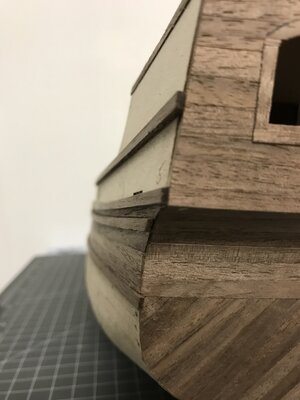- Joined
- Oct 11, 2021
- Messages
- 734
- Points
- 403

Hello shipmates,
Before we are getting started with my new buildlog, a short introduction of myself and the ship is in order.
I'm a new member of this forum, and I live in The Netherlands a small country in Europe. I'm also a member of other fora. So posting on a forum is not new to me. Some of you may already know me perhaps by another nickname. If you recognize me, don't worry it's me!
At this moment I've found some spare hours to work on my hobby, and I would like to share this buildlog with you guys and gals. The ship is already finished but I'll share the step by step process with quick updates if you don't mind. Please have a bit patience on my written English, because it's not my native language and so I'll probably make some grammatical mistakes and I make my apologies upfront...

To the project...

I'll just hope my build won't end as the real ship did....


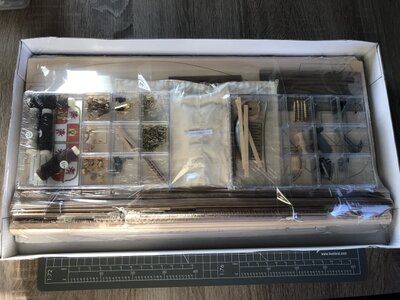

Everything looks neat and tidy at first glance. The box is well organized and the wooden parts and timber are of a good quality as can be expected from AL.
However, the manual turns out to be very disappointing. A few photo's on a single page and an instruction list is all that's added to the box. The best parts are the two bigger drawings of the rigging and masts which looks very nice doh. I believe this is an older kit from AL, in the meantime this kit has been updated. I'm not sure if that was a good thing. Walnut has been replaced by Sapeli, a reddish almost mahogany type of wood. In my opinion, Sapeli gives the model a "cheaper" appearance to walnut. This is the "older" kit with all the walnut parts, strips and so on.
The Bulkheads and false keel / keelplate
I start by numbering all the bulkheads and parts on the plate. They are all lasercut, so that's a plus due to accuracy and I use some sandpaper to remove the burn from the laser.
After inspecting a collect all the parts and dry-fit them together to see how good it fits....



After some corrections, the bulkheads fits nicely on the false keel. However I noticed a small warp in the keelplate.
I did some further inspection and Yes, it's warped a tiny bit just between bulkhead 12 and 10. It's almost common with multiplex parts these days. *Sigh*
let's have some fun to straighten out this piece of multiplex.


This needs to be fixed otherwise I run into some problems later on....I took the keel plate and soaked it in some water. I let it dry between a couple of books with some pressure on the books so the plate was fixed into a flat position. I let it dry for a day and the next day it was straight.
I put everything together again and glued the bulkheads into position. Come on!!! What else you've got and want to throw at me....
Deck plates
Next step is to place the false deck on top of the bulkheads. Again, the false keel was pre-fabricated and lasercut.
I use the small brass nails and glue to fixate the plate on to the bulkheads. I have limited tools and clamps at my possession at this moment, so I use the nails.
They will be covered up later when the final layer of thin wooden strips are placed on top of the false deck.

Don't worry about the nails. I didn't hit them to hard on the head....
Some "attachments" were placed at the bow of the ship. This will come in handy when her "parts" will be covered with some wood.
After that, it's time to fair her "parts"....errr bulkheads....




So far...so good. Until next time my friends, regards!
Ptèr
Before we are getting started with my new buildlog, a short introduction of myself and the ship is in order.
I'm a new member of this forum, and I live in The Netherlands a small country in Europe. I'm also a member of other fora. So posting on a forum is not new to me. Some of you may already know me perhaps by another nickname. If you recognize me, don't worry it's me!
At this moment I've found some spare hours to work on my hobby, and I would like to share this buildlog with you guys and gals. The ship is already finished but I'll share the step by step process with quick updates if you don't mind. Please have a bit patience on my written English, because it's not my native language and so I'll probably make some grammatical mistakes and I make my apologies upfront...
To the project...

History
The Santa Maria originally named La Gallega, was the largest of the three ships used by Christopher Columbus in his first voyage. Her master and owner was Juan de la Cosa. She was built in Pontevedra, Galicia, in Spain's north-west region. Santa Maria was probably a medium-sized nau (Carrack), about 58ft long on deck, and according to Juan Escalante de Mendoza in 1575, SM was "very little larger than 100 toneladas" (about 100 tons, or tuns). She was the flagship for the expedition aside La Nina and La Pinta, two smaller of the caravel-type ships.Shipwreck
With three masts, Santa María was the slowest of Columbus' vessels but performed well in the Atlantic Ocean crossing. Then on the return trip, on 24 December (1492), not having slept for two days, Columbus decided at 11:00 p.m. to lie down to sleep. The night being calm, the steersman also decided to sleep, leaving only a cabin boy to steer the ship, a practice which the admiral had always strictly forbidden. With the boy at the helm, the currents carried the ship onto a sandbank, running her aground off the present-day site of Cap-Haïtien, Haiti. It sank the next day and was lost forever...I'll just hope my build won't end as the real ship did....
The build, off we go!
At first, let's inspect the workplace, which is the kitchen table in a temporary home, and the box...and yes, the box on the left is my toolkit and on the right the ship...


Everything looks neat and tidy at first glance. The box is well organized and the wooden parts and timber are of a good quality as can be expected from AL.
However, the manual turns out to be very disappointing. A few photo's on a single page and an instruction list is all that's added to the box. The best parts are the two bigger drawings of the rigging and masts which looks very nice doh. I believe this is an older kit from AL, in the meantime this kit has been updated. I'm not sure if that was a good thing. Walnut has been replaced by Sapeli, a reddish almost mahogany type of wood. In my opinion, Sapeli gives the model a "cheaper" appearance to walnut. This is the "older" kit with all the walnut parts, strips and so on.
The Bulkheads and false keel / keelplate
I start by numbering all the bulkheads and parts on the plate. They are all lasercut, so that's a plus due to accuracy and I use some sandpaper to remove the burn from the laser.
After inspecting a collect all the parts and dry-fit them together to see how good it fits....



After some corrections, the bulkheads fits nicely on the false keel. However I noticed a small warp in the keelplate.
I did some further inspection and Yes, it's warped a tiny bit just between bulkhead 12 and 10. It's almost common with multiplex parts these days. *Sigh*
let's have some fun to straighten out this piece of multiplex.


This needs to be fixed otherwise I run into some problems later on....I took the keel plate and soaked it in some water. I let it dry between a couple of books with some pressure on the books so the plate was fixed into a flat position. I let it dry for a day and the next day it was straight.
I put everything together again and glued the bulkheads into position. Come on!!! What else you've got and want to throw at me....
Deck plates
Next step is to place the false deck on top of the bulkheads. Again, the false keel was pre-fabricated and lasercut.
I use the small brass nails and glue to fixate the plate on to the bulkheads. I have limited tools and clamps at my possession at this moment, so I use the nails.
They will be covered up later when the final layer of thin wooden strips are placed on top of the false deck.


Don't worry about the nails. I didn't hit them to hard on the head....
Some "attachments" were placed at the bow of the ship. This will come in handy when her "parts" will be covered with some wood.
After that, it's time to fair her "parts"....errr bulkheads....




So far...so good. Until next time my friends, regards!
Ptèr






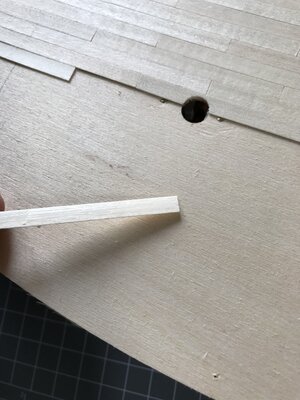





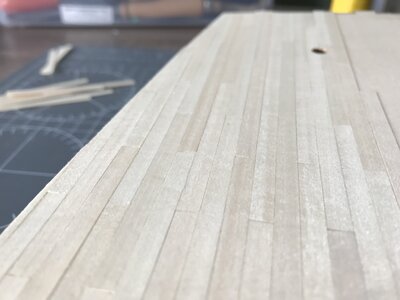





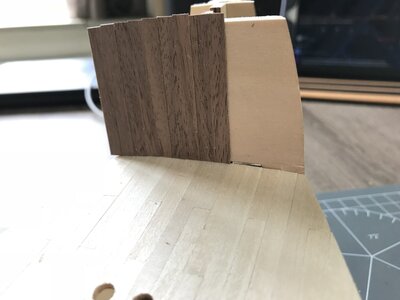





























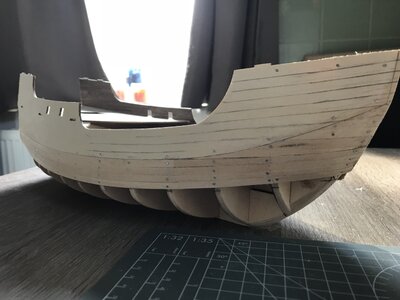





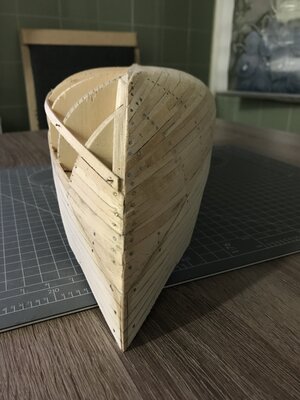

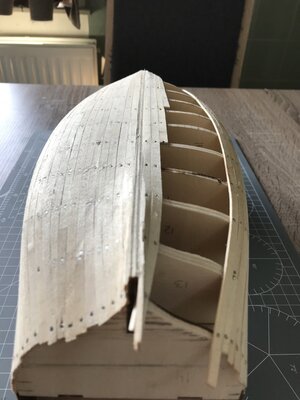



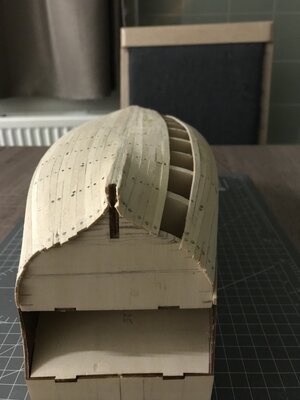



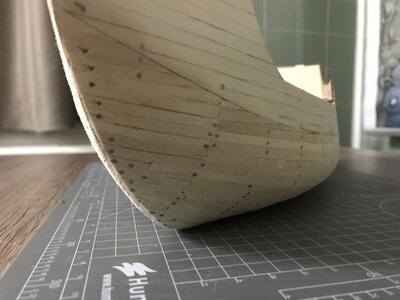




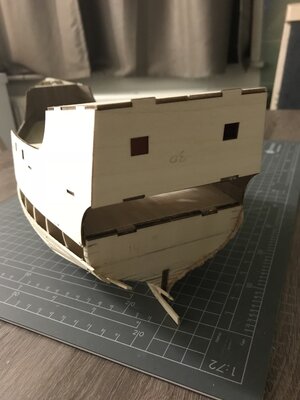


















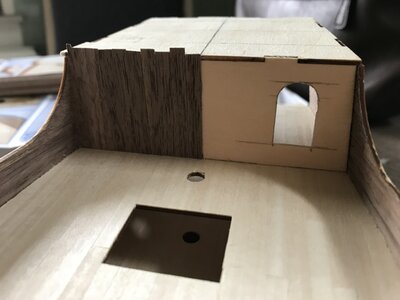







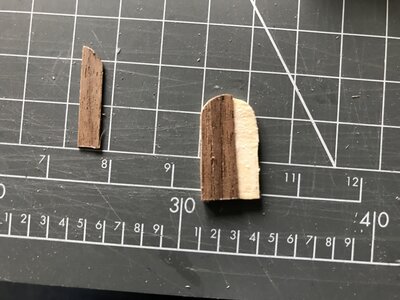
















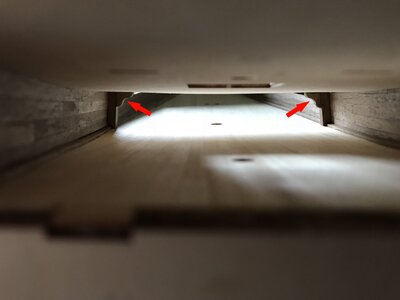

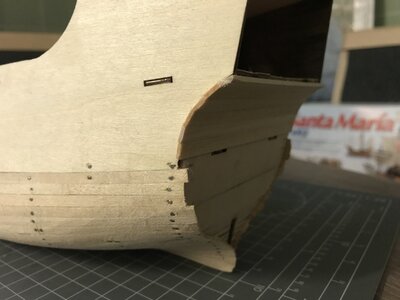












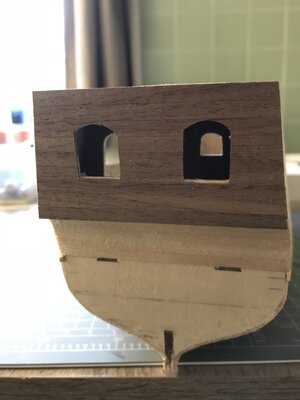























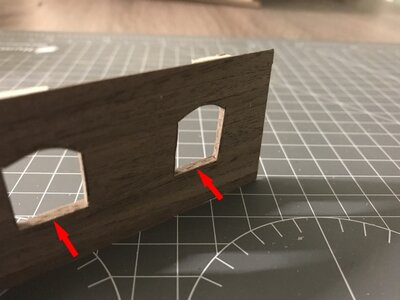


















 , I know now the door should open to the outside instead of the inside and the door should have a hinge lock instead of a knob. My mistake....errr....happy accident?!
, I know now the door should open to the outside instead of the inside and the door should have a hinge lock instead of a knob. My mistake....errr....happy accident?!









